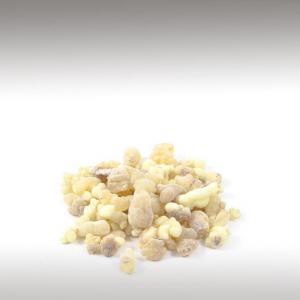
OMANI FRANKINCENSE ESSENTIAL OIL (BOSWELLIA SACRA) - ESSENTIAL OILS

BASE / GENERAL DATA
Information submited: March 4, 2015 Modified: March 15, 2018 By: OperaDreamhouse
Botanical Name: Boswellia sacra
Common Method of Extraction: Steam Distilled
Part Typically Used: Resin
Color: Pale yellow
Consistency: Thin
Perfumery Note: Base
Strength of Initial Aroma: Sweet, light, almost floral aroma,
The English word is derived from Old French "Franc Encens" (high quality incense).
Frankincense, also called Olibanum, is an aromatic resin used in incense and perfumes, obtained from trees of the genus Boswellia in the family Burseraceae, particularly Boswellia Sacra. It is native to the Arabian Peninsula (Oman, Yemen), and northeastern Africa (Somalia).
Boswellia sacra is abundant in Oman and southern Yemen in arid woodland, on the steep, precariously eroding slopes in the mountains of Dhofar, but it is most prevalent in northern Somalia.
This species of Boswellia is a small deciduous tree, which reaches a height of 2 to 8 m, with one or more trunks. Its bark has the texture of paper and can be removed easily. It has compound leaves and an odd number of leaflets, which grow opposite to one another along its branches.
The trees start producing resin when they are about 8 to 10 years old. As the resin is exuded it hardens and the tears are collected 2 - 3 times a year. On average, a tree will produce 1 kilogram of resin per year which can then be extracted into approximately two 15ml bottles of pure essential oil.
The Boswellia Sacra resin is extracted by making a small, shallow incision on the trunk or branches of the tree or by removing a portion of the crust of it. The resin is drained as a milky substance that coagulates in contact with air and is collected by hand.
Trees in the narrow fog-laden zone where the desert meets Dhofar mountain range, a region known as the Nejd, grow extremely slowly and produce very high quality resin in large, white clumps. Not surprisingly, Omanis and other Gulf State Arabs consider this to be superior to all other resins produced in North and Northeast Africa, India and Asia, and it is priced accordingly.
The trees in the Dhofar region of Oman are revered as a gift from God. This Frankincense oleogum resin oil was steam distilled and wild harvested in the Dhofar Valley of Oman. Boswellia Sacra essential oil was prepared from Omani Hougari grade resins through hydrodistillation at 78 or 100 °C for 12 hours.
Chemical structure:
Frankincense essential oil contains 8% sesquiterpenes and is 78% monoterpenes. Monoterpenes are known to be calming and restorative.
Distillation method: This essential oil is also produced by CO2 extraction, specifically, because the CO2 oil naturally contains heavier-weight molecules not found in the steam distilled oil, and an overall large percentage of the oil is also of these molecular forms. So in CO2 extraction Frankincense essential oil you get the best of both worlds: the bright, sweet notes of a steam distillation, and the heaviermolecular weight compounds found in a CO2 extract.
Although from time immemorial this resin is distilled with steam, and this is a classic way. Both methods are good: CO2 extraction is a new way of extracting, and steam distillation is classic way of extraction.
Common Method of Extraction: Steam Distilled
Part Typically Used: Resin
Color: Pale yellow
Consistency: Thin
Perfumery Note: Base
Strength of Initial Aroma: Sweet, light, almost floral aroma,
The English word is derived from Old French "Franc Encens" (high quality incense).
Frankincense, also called Olibanum, is an aromatic resin used in incense and perfumes, obtained from trees of the genus Boswellia in the family Burseraceae, particularly Boswellia Sacra. It is native to the Arabian Peninsula (Oman, Yemen), and northeastern Africa (Somalia).
Boswellia sacra is abundant in Oman and southern Yemen in arid woodland, on the steep, precariously eroding slopes in the mountains of Dhofar, but it is most prevalent in northern Somalia.
This species of Boswellia is a small deciduous tree, which reaches a height of 2 to 8 m, with one or more trunks. Its bark has the texture of paper and can be removed easily. It has compound leaves and an odd number of leaflets, which grow opposite to one another along its branches.
The trees start producing resin when they are about 8 to 10 years old. As the resin is exuded it hardens and the tears are collected 2 - 3 times a year. On average, a tree will produce 1 kilogram of resin per year which can then be extracted into approximately two 15ml bottles of pure essential oil.
The Boswellia Sacra resin is extracted by making a small, shallow incision on the trunk or branches of the tree or by removing a portion of the crust of it. The resin is drained as a milky substance that coagulates in contact with air and is collected by hand.
Trees in the narrow fog-laden zone where the desert meets Dhofar mountain range, a region known as the Nejd, grow extremely slowly and produce very high quality resin in large, white clumps. Not surprisingly, Omanis and other Gulf State Arabs consider this to be superior to all other resins produced in North and Northeast Africa, India and Asia, and it is priced accordingly.
The trees in the Dhofar region of Oman are revered as a gift from God. This Frankincense oleogum resin oil was steam distilled and wild harvested in the Dhofar Valley of Oman. Boswellia Sacra essential oil was prepared from Omani Hougari grade resins through hydrodistillation at 78 or 100 °C for 12 hours.
Chemical structure:
Frankincense essential oil contains 8% sesquiterpenes and is 78% monoterpenes. Monoterpenes are known to be calming and restorative.
Distillation method: This essential oil is also produced by CO2 extraction, specifically, because the CO2 oil naturally contains heavier-weight molecules not found in the steam distilled oil, and an overall large percentage of the oil is also of these molecular forms. So in CO2 extraction Frankincense essential oil you get the best of both worlds: the bright, sweet notes of a steam distillation, and the heaviermolecular weight compounds found in a CO2 extract.
Although from time immemorial this resin is distilled with steam, and this is a classic way. Both methods are good: CO2 extraction is a new way of extracting, and steam distillation is classic way of extraction.

SPIRITUAL PRACTISES DATA

MEDICINE / HEALTH DATA

BEAUTY / COSMETICS DATA

FOOD / COOKING DATA
COMMENTS
No comments.
Newest mixtures containing Omani Frankincense Essential Oil (Boswellia Sacra):

Mixture for treat dry cough
March 8, 2015

Massage oil recipe for pain relief
March 8, 2015

Essential Oil for the Seventh Chakra (The Crown Chakra - Sahasrara)
March 6, 2015

Essential Oil for the Sixth Chakra (Third Eye Chakra - Ajna)
March 4, 2015


